RENEGADE GARDENER™
The lone voice of horticultural reason
The 2010 Renegade Gardener High Spot/Black Spot Awards

Your host, Don Engebretson, the Renegade Gardener™
1-1-11/Tower, Minnesota – Greetings to renegade gardeners from around the globe, and welcome to the 11th Annual Renegade Gardener High Spot/Black Spot Awards! The award ceremony comes to you tonight live from the fabulous Fortune Bay Resort Casino, located on the breathtaking shore of northern Minnesota’s Lake Vermillion.
 And I do literally mean breathtaking, mainly because outside it must be seventy degrees below zero. This morning, one of our Japanese guest judges stepped outside for a smoke only to discover that at these temperatures, your nostrils freeze shut immediately, air through the mouth collapses the lungs, all your blood rushes to your feet, and three puffs of a Marlboro contain every bit the mind-altering properties of about a pound-and-a-half of premium Dutch-grown Sativa marijuana.
And I do literally mean breathtaking, mainly because outside it must be seventy degrees below zero. This morning, one of our Japanese guest judges stepped outside for a smoke only to discover that at these temperatures, your nostrils freeze shut immediately, air through the mouth collapses the lungs, all your blood rushes to your feet, and three puffs of a Marlboro contain every bit the mind-altering properties of about a pound-and-a-half of premium Dutch-grown Sativa marijuana.
He stole a snowmobile, raced into town, robbed the Tower Bank, bought forty-dozen donuts at the Tower Bakery, actually sat through all 108 dreadful minutes of “The Tourist” at the Tower Cinema, came back, and voted RenegadeGardener.com “Best Gardening Site.” He also commented that the donuts at the Tower Bakery were the best tasting food he’s eaten in his life, even better than geoduck (Panopea generosa, Google it).
I immediately put him in charge of lighting and vote tabulation, and it looks as if we are ready to proceed. So let’s present the first award, please…
High Spot Award
Native Plant of the Year:
Impatiens pallida (Common name: Pale Jewelweed)
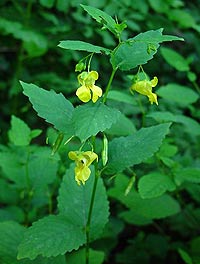 You have to love plants that exhibit intelligence. A woodland plant found throughout eastern North America, I. pallida can tell with its roots whether a neighboring plant is its sibling. If it is, this considerate native reduces the amount of nutrients it draws from the soil, a botanical “share and share alike” mindset, one that has been observed in several other plants.
You have to love plants that exhibit intelligence. A woodland plant found throughout eastern North America, I. pallida can tell with its roots whether a neighboring plant is its sibling. If it is, this considerate native reduces the amount of nutrients it draws from the soil, a botanical “share and share alike” mindset, one that has been observed in several other plants.
Researchers at McMaster University in Ontario, however, have discovered that when growing in a happy swath of siblings, I pallida not only shares nutrients below ground, it grows taller stalks with fewer leaves, thus sharing the sunlight as well. Growing next to unrelated plants, no matter how sparse or crowded, the plant takes on a more selfish attitude, growing shorter, leafier stalks – the first time this form of above ground behavior has been recorded.
— From The Smithsonian, February 2010
Black Spot Award
Most Careless Magazine Gardening Article:
“Collector’s Choice” by Daniel J. Hinkley
Horticulture magazine, August/September 2010
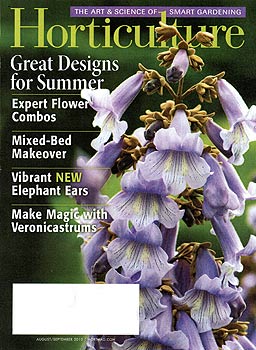
Trusses of tubular flowers borne on China’s empress tree grace the cover of the August/September 2010 issue of Horticulture.
Southern fur was flying after a recent issue of Horticulture hit the mailboxes and newsstands. Globetrotting plantsman Dan Hinkley had contributed an article on large-leaved plants and their use in the landscape. Among his recommendations: Paulownia tomentosa, commonly known as the empress tree, native to central and western China.
“It is not only perennials that do the business of providing loudness of leaf,” wrote Hinkley. “There exist a bevy of trees appropriate to numerous climates that handily perform the task. Paulownia tomentosa (Zone 5), the empress tree, presents trusses of purple tubular flowers from brown felted buds in spring, followed by cordate (heart-shaped), lobed velvety foliage throughout the summer.”
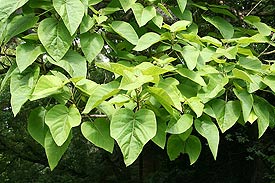 Sounds heavenly – sign me up. Only one small problem: The plant (also known as the princess tree) has proven to be terribly invasive and is deemed as such by the U.S. Government, as well as the departments of natural resources in over a dozen states, from the east coast to the deep south to Texas. It is a self-seeding monster – a single tree is capable of producing an estimated twenty million seeds that are easily transported long distances by wind and water. All the more menacing when you consider that each seed can grow into a 50-foot tree.
Sounds heavenly – sign me up. Only one small problem: The plant (also known as the princess tree) has proven to be terribly invasive and is deemed as such by the U.S. Government, as well as the departments of natural resources in over a dozen states, from the east coast to the deep south to Texas. It is a self-seeding monster – a single tree is capable of producing an estimated twenty million seeds that are easily transported long distances by wind and water. All the more menacing when you consider that each seed can grow into a 50-foot tree.
Members of the North Carolina Native Plant Society were not pleased by the article, its members having first-hand experience with this seductive, lumbering thug of a plant that now disrupts native habitat and wildlife in every portion of their state. A letter was written, and published in the next issue of Horticulture, but the editorial response was underwhelming. If you grow it, keep it cut back and don’t allow the plant to flower, was the essence of the tepid reply.

Green portions represent serious infestation areas of Paulownia tomentosa.
To be fair, Hinkley writes further in the article that, “I have taken to coppicing my specimen to three feet each year. This sacrifices the flowers, but the resulting re-growth carries embarrassingly large leaves that often initially perplex even the best of visiting plantsmen.” All well and good, except for his earlier, titillating description of the plant in bloom – and the fact that the cover of the August/September issue in which the article appeared features a close-up photo of the tree in flower!
Here’s a link to the warning sheet on Paulownia provided by the Plant Conservation Alliance: Princess Tree
The brouhaha surrounding the article brings to mind two additional thoughts:
First, plant lover that I am, I believe it’s time to severely question the wisdom of the exotic plant tradesmen and women of the modern era. Problem is, these people have never met a plant they didn’t like, and if escorting some fetching find home from China or Vietnam or Yukon Territory for the commercial purpose of offering it for sale in North America (or just the parlor trick of stumping an esteemed visiting plantsmen), well, maybe it’s time to stop.
There wasn’t a single dandelion in North America when the Mayflower arrived in 1620. By 1671 they covered the continent, brought over by European immigrants who used the plant medicinally and as part of their diet. OK, no huge ecological travesty, unless perhaps you consider the millions of gallons of synthetic and organic chemicals that have been poured onto the Earth in North America over the years in an effort to control dandelions.
Move forward to less than a century ago. I live in a beautiful part of Minnesota, wooded, lakes everywhere, hills, meadows, lovely native trees, shrubs and wildflowers throughout. Except that in the 1920s, nurserymen introduced European buckthorn to St. Paul, as a hedging material for the large mansions being built on the still-prestigious Summit Avenue.
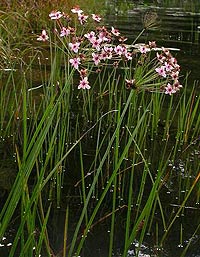
Butomus umbellatus.
Now it’s everywhere, and in Minnesota is known as invasive plant public enemy number one. Buckthorn grows so thick in woods near my home that you can’t enter them. It grows so thick, nothing else grows there. It grows so thick, the wildlife moves out. It was introduced here by people who admired it as a landscape plant.
Most heartbreaking is the arrival of another invasive to my favorite place on earth, Northwestern Ontario. Flowering Rush (Butomus umbellatus) is a Eurasian native plant that has been spreading along the U.S./Canada border since first introduced by the nursery trade as an exotic ornamental water plant. It quickly leaped into the wild with devastating consequences, choking the St. Lawrence and threatening all manner of recreational water use in addition to native plants and wildlife. I’ve seen it so thick on wilderness beaches and in channels and bays in Ontario that you can’t enter them – beaches and channels and bays that were void of the plant ten years ago.
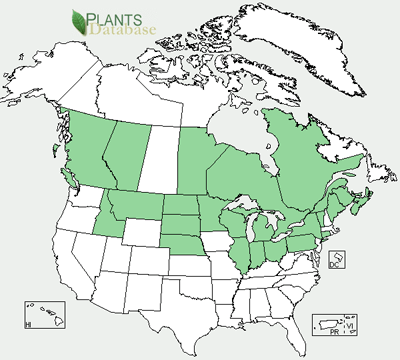 |
| Current range of invasion by Flowering Rush, originally brought to the eastern U.S. by a plantsman who found it an attractive ornamental water garden plant. |
What are we doing? What if it hadn’t been dandelions introduced to North America 400 years ago, but Paulownia tomentosa? Will my son, my grandchildren, be able to fish and canoe and swim in the wilderness waterways of Ontario in the decades to come? Don’t we ever learn?
My second realization: Are national gardening magazines even necessary anymore? When you have national magazines that can’t even fact-check for invasive plants, what purpose are they serving? Whereas I may not be sold on the “eat local” craze, I think I’ll start a new movement of my own: “read local.” Virginia Gardener magazine isn’t going to write about plants invasive to Virginia, unless it’s a warning.
After all, what’s more regional than gardening? How many times have you cancelled a subscription to a national magazine because half of it was information on plants not compatible to your zone? I say, start supporting state and regional gardening magazines, association and club newsletters, and university and other local websites. Your money and time will be better spent.
Hey, that’s a perfect segue to the next award…
High Spot Award
Best Gardening Magazine:
Northern Gardener
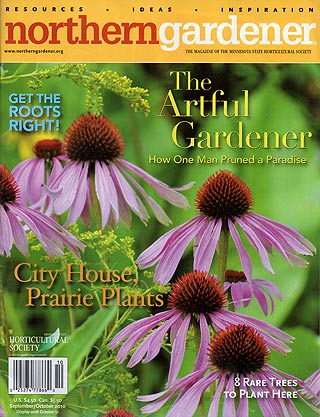 Yet another High Spot Award – the third, I believe – for a magazine that represents everything a great gardening magazine should be. And lest you think I’m prejudiced – I write for the rag – in November, Northern Gardener received the Gold Award for overall excellence at the annual Minnesota Magazine and Publishing Association annual meeting.
Yet another High Spot Award – the third, I believe – for a magazine that represents everything a great gardening magazine should be. And lest you think I’m prejudiced – I write for the rag – in November, Northern Gardener received the Gold Award for overall excellence at the annual Minnesota Magazine and Publishing Association annual meeting.
The judges – real judges – for the Gold Award looked at writing, photography, design, even advertising layout, and deemed Northern Gardener tops. The greatest thing about the magazine? It’s regional. Tips, techniques, plants, landscapes and gardens solely for USDA Zones 2 through 5 baby, everyone else, take a hike. No eloquent dissertations on some fancy-schmancy, zone 7, Flowering Wimp Plant that wouldn’t last ten seconds north of Des Moines. No siree.
Published by the Minnesota State Horticultural Society, Northern Gardener has satisfied subscribers from Maine to Alaska and across much of Canada. You can view a table of contents, read a recent article, and subscribe by visiting www.northerngardener.org.
High Spot Award
Best Movie of the Year:
A Chemical Reaction – The Story of a True Green Revolution
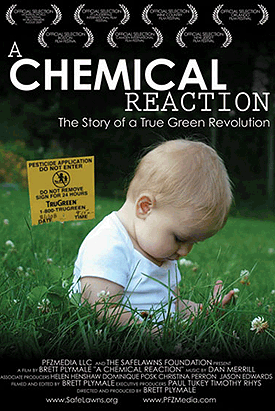 A Chemical Reaction is essentially the story of Hudson, Quebec, the little town that banned pesticide use over concerns about public health, then battled the big synthetic chemical industry over the ban all the way to the Canadian Supreme Court. I first heard about this 80-minute, 2010 documentary film while perusing GardenRant.com, where both the Ranters and their loyal readers were granting it high praise as one of the most important gardening/ecological films of our time.
A Chemical Reaction is essentially the story of Hudson, Quebec, the little town that banned pesticide use over concerns about public health, then battled the big synthetic chemical industry over the ban all the way to the Canadian Supreme Court. I first heard about this 80-minute, 2010 documentary film while perusing GardenRant.com, where both the Ranters and their loyal readers were granting it high praise as one of the most important gardening/ecological films of our time.
I like the women of GardenRant, love their blog, but being the Renegade Gardener – the original, irreverent, grand father (as opposed to grandfather) of garden ranters – I sat down for a private screening of the film a few months ago with one pre-determined, grossly prejudicial goal in mind: blow this film and its cloying, gooey-green premise clear out of the water.
I can’t. It’s a helluva film. I purchased a copy on CD, and spent days viewing it slowly, taking pages of notes, then fact-checking to see if I could find any major flaws or inaccuracies. Most were minor, and had to do with not-so-subtle film work where some images and events were obviously staged for the camera – a cute little girl eating grass, fertilizer dust blowing into a house through an open window, etc. All documentaries that are trying to convince you of something include stuff like that, and I grant them some poetic license.
There are semantic gaffes; sometimes the word “pesticide” is used to imply every chemical under the sun, when in fact even the broadest definition of the word limits it to insecticides (insect pests) and herbicides (fungal and viral pests). A few minutes are devoted to condemning Roundup and glyphosate-based garden products, of course, even though their use has nothing to do with the health issues and the synthetic chemical industry’s denial tactics that are exposed during the film. Monsanto, purveyors of Roundup, isn’t mentioned in the film; it’s Chemlawn/TruGreen, Scott’s and Ortho that bear the brunt of the film’s wrath.
In another brief segment, a University of Guelph (Ontario) expert points out that chances of harm to humans from these chemicals are infinitesimal if proper clothing is worn and label directions are followed properly. And he’s exactly right. A filmmaker controls content, however, so as presented, with what precedes and follows the segment, if you’re not keeping an open mind, the expert comes off as an ignorant fool.
Use of lawn fertilizers are linked, wholly unscientifically, to excess algae growth in the Chesapeake Sound, when any good reader of this site knows that lawn fertilizers are a very minor player in that whole problem. (To review, read Every Curb is a Shoreline.)
But for the most part, my criticism ends there. By my account, around eighty-five percent of the film is truthful and scientifically substantiated. That’s not damning with faint praise – eighty-five percent, in this day and age of documentary filmmaking, is damn good.

Filmmaker, journalist and organic lawn guru Paul Tukey
You will be frightened, appalled, incensed and bewildered. Paul Tukey, the film’s creator, who also serves as narrator and on-camera investigative reporter, paints a mostly factual and completely compelling picture of a lawn care and synthetic garden chemical industry that clearly favors profit over complete public health safety. He slips up, such as when he compares “toxic chemicals” with “organic treatments” (what he means are toxic synthetic chemicals versus toxic organic chemicals), but halfway through, I had to hand it to the guy. He’s fighting a very worthy cause.
I strongly recommend viewing of the film. It’s extremely professional, well paced and highly entertaining. You can watch a trailer and buy a copy ($19.95) at www.safelawns.org, but a few warnings: If you watch the film, you’ll never hire a lawn service company again. You’ll also be damn careful when using garden chemicals (synthetic AND organic, need I remind you).
Finally, if you order the film, Paul Tukey becomes your best friend in the world, and you will be inundated weekly via e-mail with tips, news, updates, and commercial offers from SafeLawns, until you tell him to knock it off.
Black Spot Award
Most Vital, Non-Gardening Marketing Question
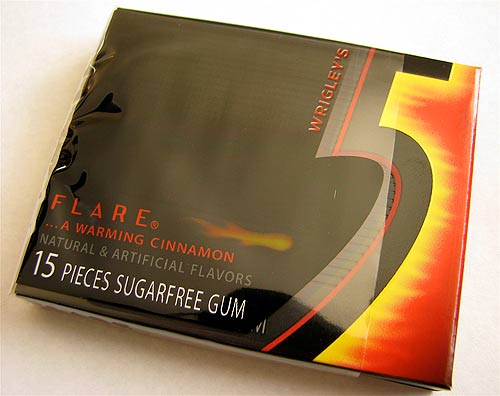 |
| When did they start packaging sticks of gum as if they were condoms? |
High Spot Award
Perennial of the Year:
Baptisia australis ‘Solar Flare’ (bap-TEASE-ee-uh aw-straw-liss)
Common Name: False Indigo
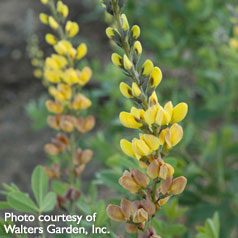 That a plant is adaptable to a wide range of soils, bothered little by disease or pests, is not dependent on a regular fertilization or watering schedule – the esteemed “easy to care for” plant one hears so much about in nursery catalogues – gains scant extra credit from me. People who enjoy sewing as a hobby don’t spend a decade making sock monkeys. One tends to move on to hats, vests and wedding dresses.
That a plant is adaptable to a wide range of soils, bothered little by disease or pests, is not dependent on a regular fertilization or watering schedule – the esteemed “easy to care for” plant one hears so much about in nursery catalogues – gains scant extra credit from me. People who enjoy sewing as a hobby don’t spend a decade making sock monkeys. One tends to move on to hats, vests and wedding dresses.
Much of the joy in gardening comes from gaining expertise in growing a wide and disparate collection of plants the presence of which you enjoy. From its infancy in your garden, each plant exhibits different behaviors hinting at different needs, much like children. These differences range from subtle to stark. As parent, your job is to discover and adapt your skills at nurturing based on these differences.
This development of skills is usually fun, occasionally frustrating. You will grow some plants that help with the dishes, do their homework without prompting, and are eager to attend Sunday school. Other plants arrive home after curfew in the back of a patrol car. That the easy plants are often plain and the bad boys always gorgeous reflects a universal principle often adapted to literature and film.
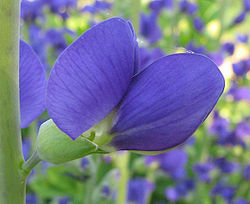
Native Baptisia australis, Blue False Indigo
Where was I? Ah yes. Adaptable to a wide range of soils, bothered little by disease or pests, and not dependent on a regular fertilization or watering schedule, Baptisia australis is in the small group of perennials that helps with the dishes, does its homework without prompting, and is eager to go to Sunday school, all the while resembling (take your pick) a young Tom Cruise, Brad Pitt, or Johnny Depp. Long-lived, the plant even matures into a smiling George Clooney.
If you are not growing Baptisia, your garden lacks one of the most distinctive and boldly elegant perennials you’ll find. An herbaceous perennial in the pea family, it is native to central and eastern North America and was used by native American tribes for making blue dyes both for clothing and face paint.

Jim Ault, Chicago Botanic Garden
Jim Ault (or, properly, James R. Ault, Ph.D), director of ornamental plant research at the Chicago Botanic Garden, has been breeding Baptisia for well over a decade and is the person primarily responsible for the introductions of new cultivars, under the Prairieblues™ series name.
‘Solar Flare’ is the newest, with lemon-yellow blooms that appear in late spring. As the blooms mature, they pass through a variety of orange hues from the bottom up. It’s a burnt orange, not a screaming orange, and the contrast between the yellow and orange in each individual bloom is fabulous. An equally gorgeous cultivar is ‘Starlight Prairieblues,’ in which the rich blue bloom color has been coerced into periwinkle with butter-cream at the heels.
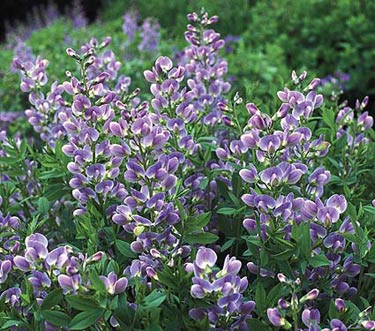
‘Starlight Prairieblues’
Plants mature into very large specimens, fairly quickly – three to five years. ‘Solar Flare’ will develop into a dense clump 3-4’ high by 4’ wide. From a design standpoint, you’re planting a shrub. Plants work just fine in the perennial garden as singles, but are amazing in large swaths if naturalizing large areas.
Each plant will send up over 100, 12-18’ flowering racemes. The perfect, blue-green, contrasting foliage is what helps make plants so distinctive. Plants will bloom for a month (deadheading does not fire off much significant re-bloom) while the foliage looks great all season.
It’s a prairie plant, so it flourishes in full sun, but I’ve grown both the native and cultivars very successfully in areas where they receive only four hours of hot, midday sun. They’ll do fine in afternoon-only sun. Plants do well in a wide variety of soil types, and easily handle things on the dry side once established. Pest and fungal problems are extremely rare. Plants develop a whopper of a taproot – think hard twice, plant once – and are very long-lived.
Listed as hardy to USDA Zones 4-8, savvy northern gardeners have already proven plants reliably hardy to zone 3. Plants will not do well in sternly acidic soils – adding a bit of lime to acidic soil to raise pH is the only mild rap on the knuckles young ruffian plants may need.
Black Spot Award
Worst Case of Eco-Hypocrisy:
U2’s “The Edge” Plans Malibu Home

U2’s the Edge shows reporters how much the environment will be impacted by his five-home development.
In a perfect example of rock star mentality, David Evans, better known as the Edge, guitarist for the most vocally Earth-hugging rock band on the planet, Ireland’s U2, came under fire this summer after California Coastal Commission officials voiced concern over plans submitted on his behalf for development of pristine wilderness coastal property recently acquired by Evans.
The proposed 156-acre development would include five houses, ranging from 7,317 to 12,000 square feet, presumably to ensure suitable living space for the Edge, his wife, and two children. Evans has assured Malibu city council members that every imaginable green building technique would be used, with an emphasis on organic materials – such as the acres of custom copper roofs, fashioned to resemble fluttering leaves. As many boulders as possible would remain untouched, swears Evans, who noted that he had already given many of them names such as Dinosaur Vertebrae and Cistern. He further claimed that the thousands of yards of soil dug up for the development would be “reused.”
“What is so silly is they say it is so green,” said Paul Edelman, the chief of planning and natural resources for the Santa Monica Mountain Conservancy, which opposes the plan. Manufacturing of the building materials, as well as the massive amount of construction equipment used during construction, all rely on the consumption of fossil fuels.

One of the Renegade Gardener’s early heroes, Alice Cooper.
Argues Evans, “We just had this dream of building a house that was in perfect harmony with these hills. The project will respect and honor the landscape.”
I can’t help but bring up this stellar quote from shock-rocker Alice Cooper, the man I wanted to be after buying (and wearing out) his album “Killer” in 1971:
“I can’t believe anyone asks our opinions on anything. We’re rock stars. We got drunk and stoned as kids and barely finished high school. We didn’t go to college. Don’t be influenced by anything we say or do – none of us have a clue.”
High Spot Award
Best Sign We Win A Small Battle Once In Awhile:
Ace Hardware Magazine Rewrites Lawn Fertilizer Copy
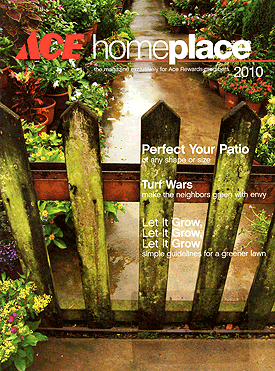 Hats off to Ace. The national hardware store chain actually has broken away from the knowingly false and hideously harmful campaign by Scott’s fertilizer to create synthetic fertilizer–dependent lawns, via Scott’s ludicrous “4-Step Fertilizer” program.
Hats off to Ace. The national hardware store chain actually has broken away from the knowingly false and hideously harmful campaign by Scott’s fertilizer to create synthetic fertilizer–dependent lawns, via Scott’s ludicrous “4-Step Fertilizer” program.
Paging through the spring, 2010 issue of Ace Homeplace (a magazine mailed to Ace Rewards members) I was amazed to read this advertorial copy in a short article on lawn care:
When Should I Fertilize?
The answer to this question depends on what part of the country you live in, how you want your lawn to look, and the type of grass you have. As a rule of thumb, it is best to fertilize your lawn when it is actively growing. However, each type of grass has its own growing season and thus its own schedule to fertilize.
Holy moly! That paragraph is within a few degrees of being entirely correct. In 2009, that sentiment wasn’t there at Ace, and in fact, this is the first instance I’ve encountered where a commercial retailer is favoring horticultural accuracy over cash register sales.
I’m even going to take some credit. How much, I don’t know, but I’ve been hammering on this topic for nearly ten years, on this site and in newspaper and magazine articles. If you are wondering what the hell I’m talking about – the myth of the 4-step lawn – click here.
Black Spot Award
Worst New Garden Product:
Thornless Roses
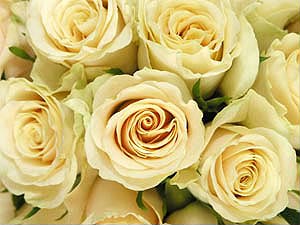 Monsters. Madmen. Mouth-breathing miscreants. Mindless masters of mayhem who should not be forgiven despite knowing not what they do. They’ve created thornless roses.
Monsters. Madmen. Mouth-breathing miscreants. Mindless masters of mayhem who should not be forgiven despite knowing not what they do. They’ve created thornless roses.
As with all evil gardening trends, the development of thornless roses has evolved in the shadows for decades, culminating in the recent arrival of a blinding array of new, thornless rose varieties, in both climbing and shrub form. What’s the problem, and reason for my contempt? It’s the principle of the thing.
Google “thornless roses” and the first listing will be the site, “rose-gardening-made-easy.com.” Need I say more? The writing on the site is so precious – and odd – as to be painful. “Growing thornless roses, especially climbers with no thorns makes the job of trimming roses so much easier. A rose with no thorns, is especially useful when gardening roses for kids.”
Errant comma use aside, what will become of the phrase, “Every rose has its thorn?” Screwing with plants to produce larger blooms, different colored blooms, greater vigor, altering foliage characteristics, messing with height and form, that’s all fine, it makes for cool plants, but you do NOT remove thorns from roses.
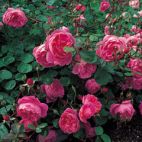 From the Gardening Central website: “One of the reasons some gardeners never grow roses is because they don’t want to have to deal with the thorns. A lot of people think flowers are hard enough to take care of without having your skin punctured every time you pick a flower or prune a rose bush. Now that problem is taken care of by the breeding of thornless roses.”
From the Gardening Central website: “One of the reasons some gardeners never grow roses is because they don’t want to have to deal with the thorns. A lot of people think flowers are hard enough to take care of without having your skin punctured every time you pick a flower or prune a rose bush. Now that problem is taken care of by the breeding of thornless roses.”
Good god, people, newsflash from the Renegade Gardener, LIFE HAS THORNS. You can lose your job, your kid will smack up the car, your spouse can have an affair, your house can be condemned for mold. LIFE HAS THORNS, an eternal and infinite principle perfectly espoused by nature and appreciated best by gardeners. You don’t mess with the material manifestation of universal truths.
You think flowers are hard enough to grow without having your skin punctured? WEAR LEATHER GLOVES, you moron, or, better advice, learn how to bowl. There, that’s your hobby. Bowling. Enjoy. You moron.
Thornless roses are great because kids can garden? KIDS HATE GARDENING. Face it, they hate it when they have to go out with you in the yard and pretend to be adult. If your child is the one in a million who does seem to enjoy gardening for more than ten seconds, great, that’s what a vegetable patch is for.
“If you are one of the people who detests thorns, take a look at some of the newer thornless roses before you give up on roses altogether.”
No, if you are one of the people who detests thorns, get the hell out of here and into therapy, and try to figure out why every other aspect of your life is also utterly unmanageable.
I quote Abraham Lincoln:
“We can complain because rose bushes have thorns, or rejoice because thorn bushes have roses.”
You’ll also complain once you see what happens when the deer get a hold of them.
My heavens, look at the time! This concludes the 2010 Renegade Gardener High Spot/Black Spot Awards. I thank you for attending – be careful on your way out, the steps are slippery – and wish you all a peaceful, fruitful and joyous new year!
Don Engebretson
The Renegade Gardener
- The 2018 Renegade Gardener High Spot/Black Spot Awards January 5, 2019
- The 2017 Renegade Gardener High Spot/Black Spot Awards January 1, 2018
- The 2016 Renegade Gardener High Spot/Black Spot Awards January 1, 2017
- The 2015 Renegade Gardener High Spot/Black Spot Awards January 1, 2016
- The 2014 Renegade Gardener High Spot/Black Spot Awards January 7, 2015
- The 2013 Renegade Gardener High Spot/Black Spot Awards January 1, 2014
- The 2012 Renegade Gardener High Spot/Black Spot Awards January 4, 2013
- The 2011 Renegade Gardener High Spot/Black Spot Awards January 1, 2012
- The 2010 Renegade Gardener High Spot/Black Spot Awards January 1, 2011
- The 2009 Renegade Gardener High Spot/Black Spot Awards January 1, 2010
- The 2008 Renegade Gardener High Spot/Black Spot Awards January 1, 2009
- The 2007 Renegade Gardener High Spot/Black Spot Awards January 3, 2008
- The 2006 Renegade Gardener High Spot/Black Spot Awards December 20, 2006
- The 2005 Renegade Gardener High Spot/Black Spot Awards December 9, 2005
- The 2004 Renegade Gardener High Spot/Black Spot Awards January 1, 2005
- The 2003 Renegade Gardener High Spot/Black Spot Awards November 19, 2003
- The 2002 Renegade Gardener High Spot/Black Spot Awards October 31, 2002
- The 2001 Renegade Gardener High Spot/Black Spot Awards October 16, 2001
- The 2000 Renegade Gardener High Spot/Black Spot Awards October 20, 2000